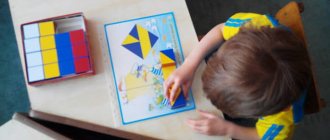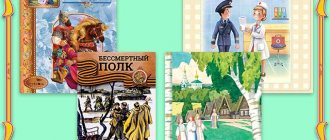Musical education for preschoolers is as important as mental arithmetic skills and basic concepts about the objects around us. It has been proven that the art of music influences the development of universal human values in a child. Children develop musical responsiveness, taste, and ideas about beauty and aesthetics.
A special author's program has been developed, which provides for the use of classical musical works in music lessons in kindergartens. This is much more productive than using a simplified musical repertoire in the form of children's and folk songs.
Children of preschool age can give a predominantly emotional assessment of musical works at the “like or dislike” level. Classical musical works listened to in preschool educational institutions form the standards of beauty in a child. Spiritual formation occurs faster, children become familiar with global cultural values.
What are the benefits of music as an educational tool?
Songs and melodies are practically the only art form that children can properly appreciate at such a young age. Even in the first months of life, babies react to melodies and can express their feelings about what they hear with their emotions. Through a lullaby, an attitude towards loved ones and art is formed.
Important
It is important to make music accessible to such a young age. For preschoolers, it is very difficult to listen to, understand and evaluate a piece of music with a duration of more than 5-7 minutes. Children simply will not be able to sit for more time in attention; this must be taken into account when planning lessons.
To solve the problem, you need to select short fragments for listening with maximum ease of comprehension. It is better to take those parts and passages that are used on television for intros to programs, in films, and in theatrical productions. Their impact on the subconscious has already been tested for years and is highly likely to cause a strong emotional response, as well as maximum results in the musical education of preschoolers.
More diagrams on the topic “Music in kindergarten”.
Zoltán Kodály's Four Element System
The author believed that a musical person is distinguished by his developed hearing, feelings, intellect and hands. At the same time, he believed that there are no children without musical abilities. Non-musical adults are learning-deprived babies. Hearing development takes place through recording a melody by ear and singing. Voice production is considered the main tool for developing abilities. A person may not be able to play an instrument, but he must be able to sing, believe supporters of this approach.
Singing with your voice, clapping your hands, beating the rhythm is the main task of such education, which, according to Zoltan Kodai, is not only the task of parents, but also of society as a whole. A musically developed child grows into a good person.
Principles of education with musical works
It is necessary to select those classical and folk melodies that will become standards of beauty for children. The education program is guided by the following principles:
- Thematic - six themes are used that are repeated periodically. These are the following topics: fairy tales, nature, musical instruments, dancing, human characters, fine arts.
- Cyclic - all the above themes are repeated with a certain frequency, this will ensure the formation of a lasting musical taste.
- Contrastive comparison of the repertoire - teachers allow students to listen to several works of different genres. After this, children express their feelings and emotions regarding what they heard, learn to distinguish between a wide variety of genres.
- Adaptability - the teacher should not use technologies for musical education of preschoolers as a mandatory template. It is necessary to focus on the level of development of a group of children and select works according to purely individual tastes. If the majority liked a certain song or melody, then it should be given to listen to as often as possible.
- Syncretism - the works being listened to should encourage children to physical activity, improvisation, rhythmic plasticity, etc. All this ensures complex development. In the future, based on the listening works, you can stage performances and perform mini-scenes.
Drawing lesson on the topic “Professions” in senior groups
Helen Hayner's Listener Technique
Having been teaching children for many years, the author of the approach came to the conclusion that it is necessary to develop the ability to listen to music, and not to raise a musician. It is important not to reach professional heights with the baby, but to teach him to love singing, dancing and playing.
Through playing the piano, which, according to the author of the methodology, is best suited, one must instill understanding and teach one to love various manifestations of musical art. Singing and listening to recorded compositions are less effective than directly extracting sounds. It is important to note that for lessons with children under 7 years old, Helen suggests using an electronic piano, which can adapt to different voices and allows you to record the game and play it back for listening. Developing your own path from simple to complex, choosing the road that will be easily mastered and will serve as an incentive. Proponents of this approach insist that difficult-to-learn material should not be given in order to avoid denial.
The choice of one or another method for teaching the basics of music depends only on the preferences of his parents. Everyone has their own path to comprehension. Preferences and aesthetic perception of musical works can be formed on the basis of one’s own developments or the experience of famous teachers. The main thing in teaching is love for the child and faith in his uniqueness.
If you liked the article, please share a link to it
Objectives of musical education of preschoolers
Music, due to its specificity and uniqueness, is the main assistant in the development of a child’s aesthetic perception.
Main goals:
- Develop an interest in music, introduce simple concepts of the melodic world, works of various composers and poets.
- Develop practical skills and actions in different types of musical activities.
- Saturate the child’s emotional sphere, fill them with impressions with the help of music and tools for its expression.
- Comprehensive, harmonious development of the child, his emotional-sensory sphere, musicality, hearing, rhythm, tact.
- To form and expand the creative abilities and imagination of preschoolers, using elements of music in various games.
- Instill musical taste by evaluating this or that compositional work.
Improvisational technique of Carl Orff “Schulwerk”
The approach is designed for children with different levels of ability and involves the development of creative imagination through the use of tools. When improvising, kids do not learn compositions from notes, but create their own. The technique suggests playing out a certain plot or story with the help of music. By singing the text, selecting movements and accompanying this by playing simple noise instruments (triangle, bell, xylophone), the child gains knowledge of how to create a pleasant sound, convey emotions not only with words, but also with sounds. By emotionally experiencing the underlying plot, finding means of expression, Carl Orff’s technique develops imagination and forms a love for such activities.
This technique combines all three main musical directions and allows you to tell your baby about music in a simple, accessible playful way. The main motives used for teaching are ethnic and folk songs from different countries. Children trained using the Carl Orff method subsequently become interested in their own culture and strive to study it.
Methods and techniques for musical education of preschool children
The following methods are used to form a musical culture:
- Contrastive comparison - a system of tasks has been developed that are based on listening to different interpretations of the same work. By contrast, students learn to understand the meaning of a work and break it down into its component parts.
- Assimilation to the character of the sound consists of an emotional adjustment to the sound and in expressing one’s attitude towards the works being listened to. Similarity can manifest itself in a variety of forms: singing along, dancing, choosing clothes, etc.
- Tactile assimilation - the teacher touches the child’s hand to set him up to listen to the musical playback for maximum insight into its essence.
- Mimic assimilation - when listening to works, children look at the teacher and expect his assessment of what is happening. To develop musical taste, you will need to show emotions that correspond to the nature of the work. For example, it is appropriate to smile, make a serious face, and show passion. Children in preschool age are subconsciously drawn to adults, copying their behavior and emotions.
- Intonation assimilation - when listening to compositions, you need to express your attitude in words and replicas. In preschool age, it is difficult for children to grasp the meaning of words, phrases or sentences if they explain the essence of the composition in difficult to understand language. Therefore, it is better to express your attitude to music in simple words that are understandable for children, but saturated with bright emotional coloring. They act directly on the subconscious, bypassing the stage of mental comprehension of what is heard.
- Color comparison - when listening to a composition, you need to show the students cards with colors and associate a certain color with the general mood of the work. For example, when listening to a calm composition, the color blue is shown; for an active and sound-rich song, you need to show the color red. When listening to subsequent melodies, you should ask the children what color this or that song is associated with.
Non-traditional drawing techniques in the 2nd junior group of preschool educational institutions
Early training of Shinichi Suzuki
Methods of early learning to play musical instruments. The author began teaching children 2-3 years old to play the violin and by the age of 4-5 he had created wonderful ensembles of little performers.
The main message is based on three ideas:
- All children are musical from birth; the main thing is to recognize talent in a timely manner and develop it.
- Only those who love children with all their soul achieve success. Being strict and demanding, you need to have a great feeling for the child, without this nothing will work.
- The best teacher is a parent. Having the proper attitude towards the baby, only a mother or father can convey to him the necessary information and teach him the necessary skills.
Training in the Suzuki technique involves daily classes, but they are aimed not so much at teaching music, but at developing a worthy and well-mannered person.
Modern technologies in musical education of preschool children
A special approach in this area of education requires the use of innovative methods and technologies. Modern inventions facilitate and determine the variety of activities of a teacher.
Thus, when listening to melodic compositions, presentations and videos are widely used. Such visibility and expanded capabilities allow you to better perceive and understand information conveyed through music.
When learning dance movements and rhythmic exercises, videos on relevant topics are used.
These methods arouse greater interest in children and contribute to better development of musicality.
The accumulation of musical experience and culture is facilitated by the technology of development of music perception by O. P. Radynova.
Maria Montessori system
Just a few words about the wonderful Italian teacher Maria Montessori (1870-1952). Maria was the first female doctor in Catholic Italy. She was not a musician, but for many years she ran a kindergarten, worked with children with disabilities, had a keen sense of child psychology and understood that music was an important component of education. Its main pedagogical principles are the interest of children and their free choice. In her kindergarten, Maria turned to the system of musical education that was closest to her. Towards the Carl Orff system. At the same time, she introduced some original features into the Orff system. This always happens when two viable systems come into contact: one feeds the other. Montessori considered the most important task of parents to be to organize a developing space for the child . So that everything he needs is at hand. Next, the baby will make his choice. In our case, the musical instruments recommended by Carl Orff were laid in front of the child, and he himself chose the one he liked best. At the right time for him.
In addition, Mary was a believer and believed that children most accurately and adequately express the plan of God, the plan of the Creator, and they are able to find their own path. Parents are more observers than educators.
Pavel Tyulenev's method
Suzuki and Nikitin have followers. Including in Russia. They try to start teaching a child to play notes very early, at 2-3 years old. “Know the notes before you walk.” This is the name of the book by Pavel Tyulenev, the author of “WORLD” - a method of intellectual development, as if continuing the idea of the book by Masaru Ibuka, who describes the Suzuki method “After Three It’s Too Late.”
Unfortunately, we cannot see the results of Tyulenev’s method as clearly as in the case of Suzuki, and therefore cannot claim that his method has been time-tested. Let us highlight the basic principles on which this method is built.
Start musical education from birth. Tyulenev is based on the research of Glen Doman, director of the Institute for the Development of Human Potential (Philadelphia, USA), and other physiologists. Doman believed that “...in the period from birth to 3 years, the brain develops very quickly, and mental capabilities at this age are unique.” According to Doman and Tyulenev, what children master through play before the age of three (learning foreign languages, reading, playing musical instruments), later on they master with difficulty.
There should be a musical instrument next to the baby's crib. The best thing is a synthesizer that a small musician can reach with his hands. According to Tyulenev, such early acquaintance with musical sounds will have a positive effect on the baby.
Cards with notes and keyboard. Such cards, on which not only notes would be written, but also parts of the keyboard showing where these notes are played, should, according to the author of the method, be in the baby’s field of vision from seven to six months. Thus, early playing with notes will become as common for him as early reading.
The time of classes and their duration are determined by the child himself. Parents create conditions for the child’s development by selecting the right educational games for him. And when to use these games and for how long, the child decides independently. In general, the direct participation of parents in the educational process, according to Tyulenev, is less significant than in other pedagogical systems.
Nothing extra. Anything distracting must be carefully avoided around the child. P. Tyulenev especially warns against unnecessary toys and other things that are not related to the development of the baby.
Encourage your child to compose music. Everything that the child plays, inventing music himself, must be listened to carefully and positively assessed. This is a child's path to creativity.
Nikitin method
The system of early education of Boris and Lena Nikitin, who raised seven healthy, harmoniously developed, and, what is important for us, music-loving children, has been one of the most popular in Russia for more than 50 years. Here are some of its main provisions.
The first year is very important. As the Nikitins themselves said, “the year of launch.”
From birth to one year, the Nikitins “launched” all directions and, so to speak, the mechanisms of the educational process. The usual attitude among moms and dads, “Well, he’ll grow up a little bit (as a rule, this “a little bit” drags on for many years)” was excluded for Boris and Lena. Their principle is that everything starts as early as possible. What is not done today will be too late tomorrow.
Don’t push, don’t interfere, but help. This fundamental principle is quite optimistic. The main task of parents, according to Nikitin, is to create opportunities (in scientific terms, to organize a developmental environment). And then the children will move on their own.
Active physical development. Hardening, plenty of sports equipment in the house, walking barefoot, cold treatment. We stopped at this position of the Nikitin family, which seems to have no direct relation to musical education, in order to emphasize: physical education is the main thing. All other areas, including music, make sense if they do not interfere with raising a healthy child.
Parental interest. One of the most important, in the opinion of Boris and Lena, is the moment that explains why no teacher or educator can fully replace mom and dad. In other words, the higher the level of interest of elders and their love for children, the higher the result.






